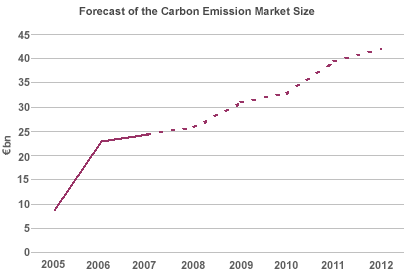The Carbon Emission Trading Market
Abstract
Celent predicts that will continue to grow despite considerable uncertainty.
Thanks to the recent Nobel laureate, Mr. Al Gore, global warming is now a well-known issue, and there is very little debate about the impact of human activities. We know that each year of delay in implementing policies to reduce our carbon emissions will make global warming disproportionately worse. From the Kyoto Protocol to the European Union Emission Reduction Scheme (EU ETS), the majority of the emission reduction schemes have been developed on a "cap and trade" system, meaning that emissions are capped at a specific level, and emission allowances and credit can be traded among participants.
reached €22 billion in 2006 and is likely to increase. While it is difficult to make assumptions about a market that is so dependent on regional and international regulations, Celent expects the market to surpass €40 billion by 2012.

The extension of EU ETS to the airline industries and the likelihood of seeing the involvement of states and regions (such as California) that are not already active clearly play in favour of strong growth in this market.
"The carbon emission market is based on ‘negative assets’ created by regulators. Therefore it is highly dependent on the regulatory framework and its evolution. But, despite lack of harmonization and regulatory uncertainty, has promising potential," says Axel Pierron, analyst at Celent and author of the report.
The carbon emission market offers a wide spectrum of instruments, and the pricing is closely related to a country’s economic situation, the price of energy commodities, and the weather. Therefore, despite regulatory uncertainty, carbon emission instruments should be included in the investment strategy of any traders targeting these markets.
"While many firms impacted by the cost of carbon emission are not yet active, it is also very surprising to see that retail banks do not offer carbon emission offsetting capabilities. With all the publicity around global warming and the increased concern about the future of our planet, retail customers are an amazingly untapped market. Expanding the scope of participants in this market will be crucial to increasing its liquidity," Axel Pierron adds.
This lack of liquidity is a plague to the carbon emission exchanges; the carbon market is still mainly an OTC market. The fact that many exchanges provide reporting capacity to market participants that conduct OTC transactions inflates the transaction volume of carbon emission exchanges. In reality, 72% of the trades in the carbon market are conducted OTC, with a significant share of bilateral trading. Axel Pierron observes: "We certainly believe that the carbon emission market is benefiting from the emergence of exchanges such as the ECX. The question is more about the economic viability of these exchanges. We have not seen any brokers jumping into the market and developing their own platforms. We estimate that the current uncertainty over the existence of the market generates too much economic uncertainty."
The report includes an analysis of the carbon emission market, defining and explaining the various emission reduction schemes, the instruments available, etc. It also examines the trading trends in carbon emission–related instruments. Four carbon emission exchanges (the ECX, the CCX, NordPool, and Powernext) are also briefly analysed.
The 38-page report contains 21 figures and 4 tables. A table of contents is available online.
Members of Celent's Securities & Investments research services can download the report electronically by clicking on the icon to the left. Non-members should contact info@celent.com for more information.

